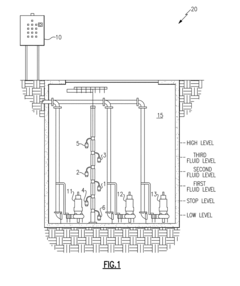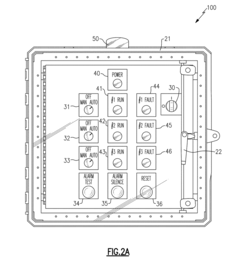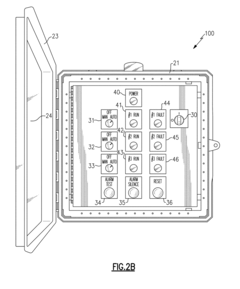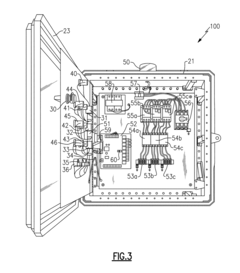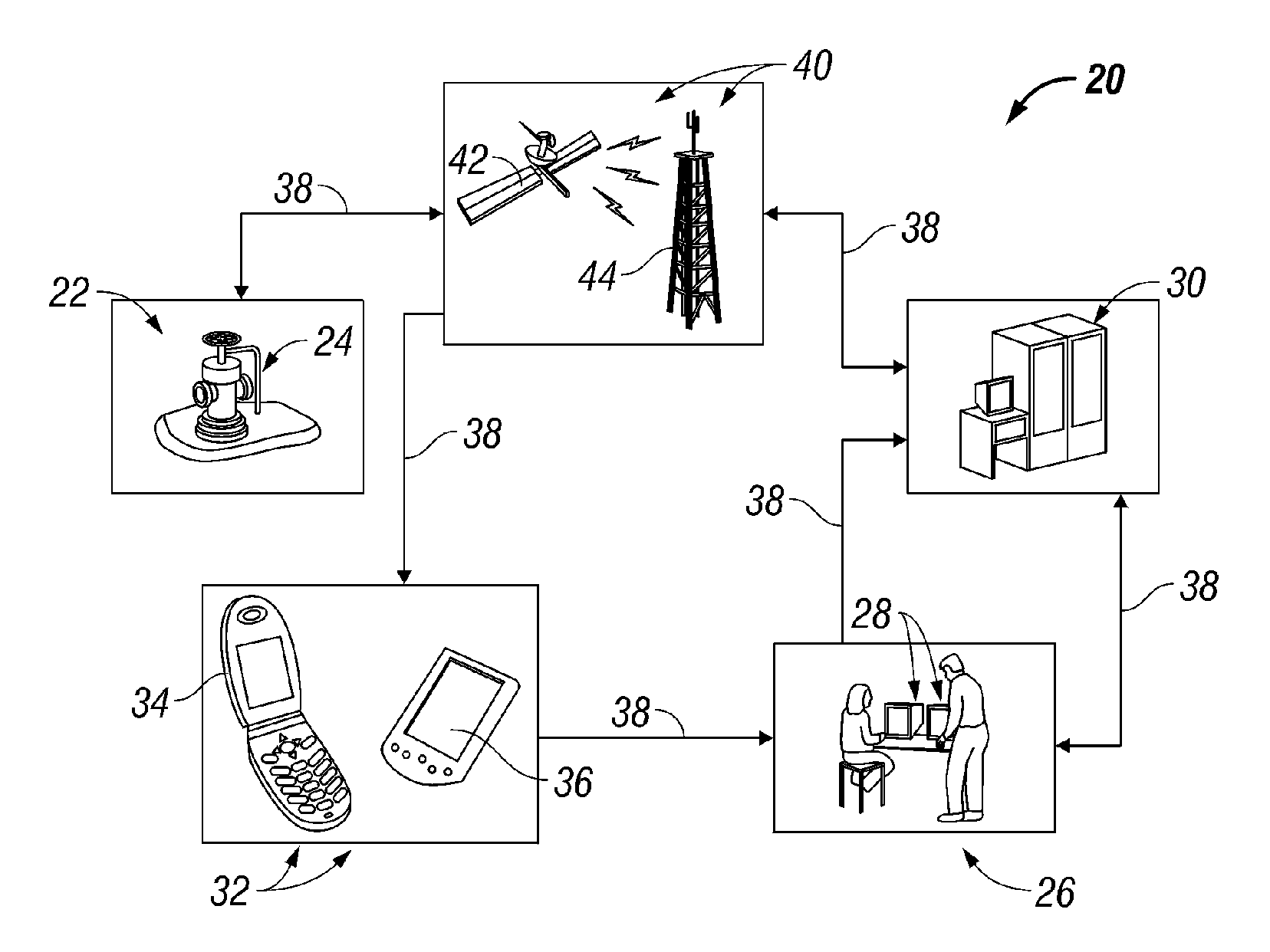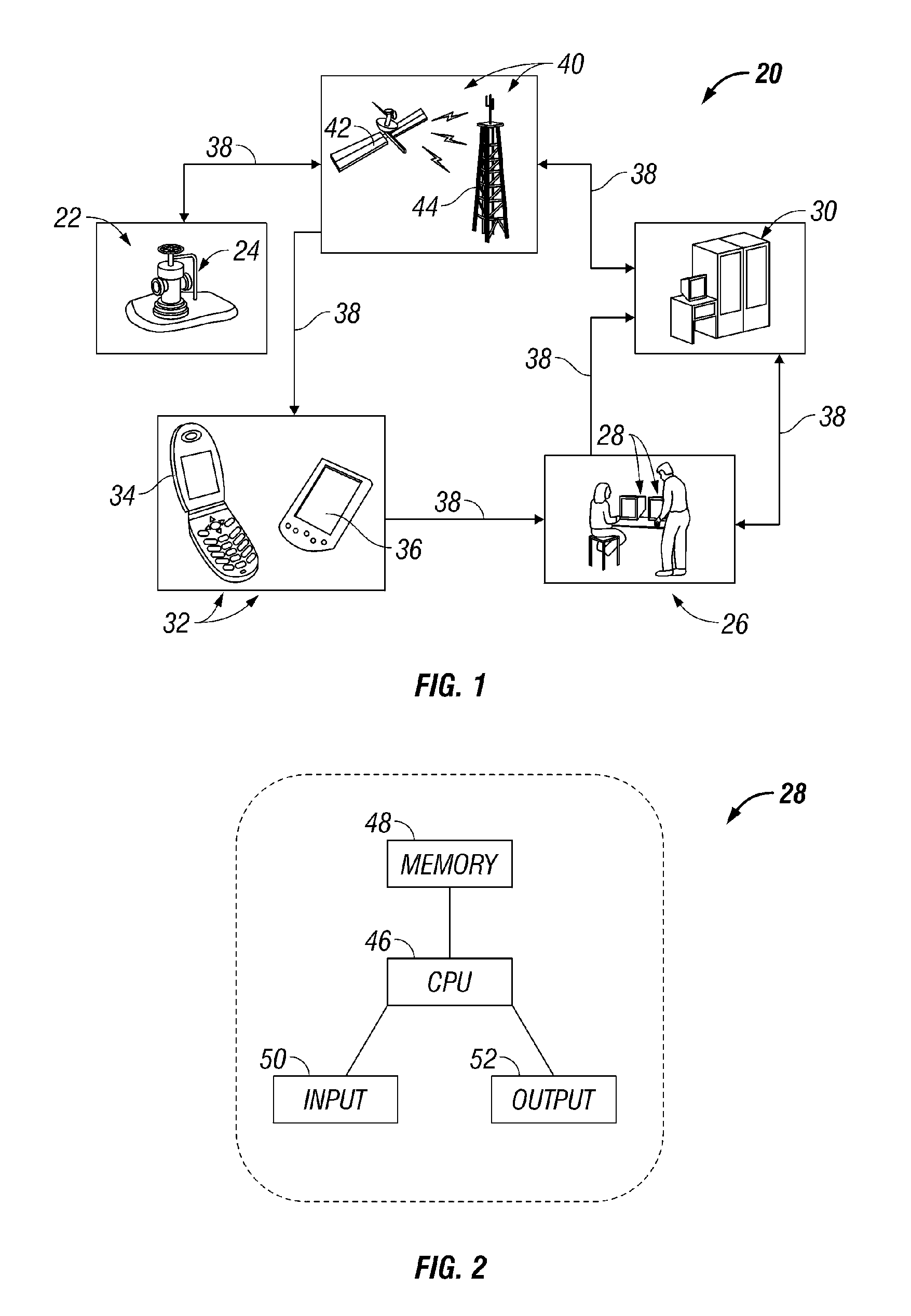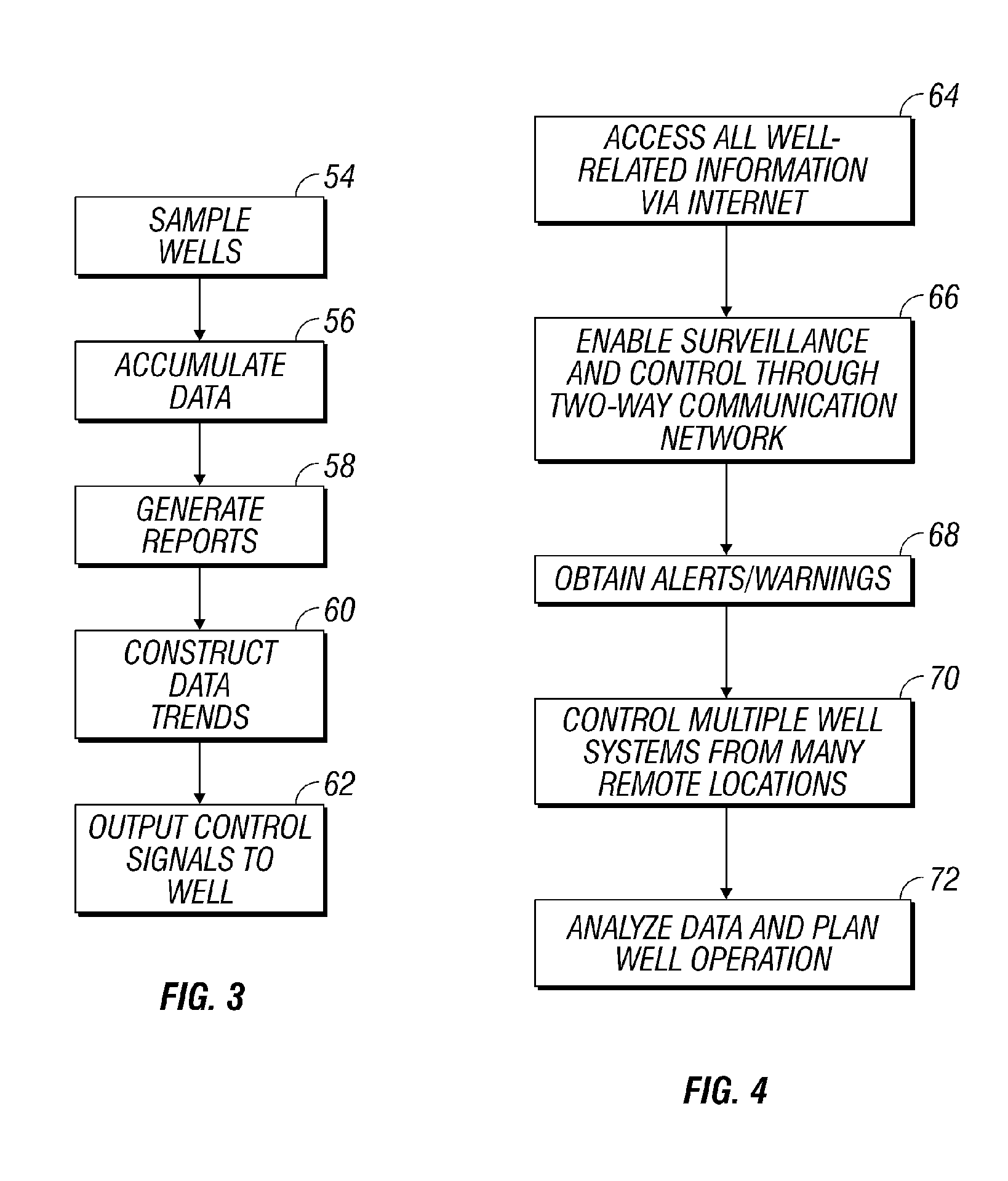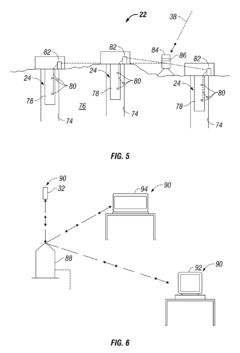How submersible pumps aid in remote sensing operations.
JUL 15, 20259 MIN READ
Generate Your Research Report Instantly with AI Agent
Patsnap Eureka helps you evaluate technical feasibility & market potential.
Submersible Pump Tech Evolution and Objectives
Submersible pumps have undergone significant technological evolution since their inception, driven by the growing demands of various industries, including remote sensing operations. The development of these pumps has been characterized by continuous improvements in efficiency, durability, and adaptability to harsh environments.
Initially, submersible pumps were primarily used for water extraction and drainage purposes. However, as remote sensing technologies advanced, the need for specialized pumping solutions in challenging environments became apparent. This led to the integration of submersible pumps into remote sensing operations, particularly in underwater and subterranean exploration.
The evolution of submersible pump technology has been marked by several key milestones. Early designs focused on increasing pump capacity and depth capabilities. Subsequently, advancements in materials science enabled the production of corrosion-resistant and high-strength components, allowing pumps to operate in more extreme conditions. The introduction of variable frequency drives and intelligent control systems further enhanced pump performance and energy efficiency.
In recent years, the development of miniaturized submersible pumps has opened up new possibilities for remote sensing applications. These compact designs allow for integration into smaller remote sensing devices, enabling more precise and localized data collection in aquatic environments. Additionally, the incorporation of sensors and telemetry systems into submersible pumps has facilitated real-time monitoring and data transmission, enhancing the overall effectiveness of remote sensing operations.
The primary objective of submersible pump technology in remote sensing is to enable efficient and reliable fluid management in challenging environments. This includes tasks such as water sampling, sediment removal, and maintaining optimal conditions for sensitive sensing equipment. By providing controlled fluid dynamics, submersible pumps play a crucial role in ensuring the accuracy and reliability of remote sensing data collection.
Looking forward, the continued evolution of submersible pump technology aims to address several key objectives. These include further miniaturization to expand the range of remote sensing applications, improved energy efficiency to extend operational durations, and enhanced integration with advanced sensing and communication technologies. Additionally, there is a growing focus on developing eco-friendly pump designs that minimize environmental impact, particularly in sensitive aquatic ecosystems.
As remote sensing operations become increasingly sophisticated, the demands placed on submersible pump technology continue to evolve. Future developments are likely to focus on smart, adaptable pumping systems that can autonomously adjust to changing environmental conditions, ensuring optimal performance in diverse remote sensing scenarios.
Initially, submersible pumps were primarily used for water extraction and drainage purposes. However, as remote sensing technologies advanced, the need for specialized pumping solutions in challenging environments became apparent. This led to the integration of submersible pumps into remote sensing operations, particularly in underwater and subterranean exploration.
The evolution of submersible pump technology has been marked by several key milestones. Early designs focused on increasing pump capacity and depth capabilities. Subsequently, advancements in materials science enabled the production of corrosion-resistant and high-strength components, allowing pumps to operate in more extreme conditions. The introduction of variable frequency drives and intelligent control systems further enhanced pump performance and energy efficiency.
In recent years, the development of miniaturized submersible pumps has opened up new possibilities for remote sensing applications. These compact designs allow for integration into smaller remote sensing devices, enabling more precise and localized data collection in aquatic environments. Additionally, the incorporation of sensors and telemetry systems into submersible pumps has facilitated real-time monitoring and data transmission, enhancing the overall effectiveness of remote sensing operations.
The primary objective of submersible pump technology in remote sensing is to enable efficient and reliable fluid management in challenging environments. This includes tasks such as water sampling, sediment removal, and maintaining optimal conditions for sensitive sensing equipment. By providing controlled fluid dynamics, submersible pumps play a crucial role in ensuring the accuracy and reliability of remote sensing data collection.
Looking forward, the continued evolution of submersible pump technology aims to address several key objectives. These include further miniaturization to expand the range of remote sensing applications, improved energy efficiency to extend operational durations, and enhanced integration with advanced sensing and communication technologies. Additionally, there is a growing focus on developing eco-friendly pump designs that minimize environmental impact, particularly in sensitive aquatic ecosystems.
As remote sensing operations become increasingly sophisticated, the demands placed on submersible pump technology continue to evolve. Future developments are likely to focus on smart, adaptable pumping systems that can autonomously adjust to changing environmental conditions, ensuring optimal performance in diverse remote sensing scenarios.
Remote Sensing Market Demand Analysis
The remote sensing market has experienced significant growth in recent years, driven by increasing demand for accurate and timely geospatial data across various industries. This demand is fueled by the need for enhanced decision-making processes, resource management, and environmental monitoring. The global remote sensing market size was valued at approximately $12.5 billion in 2020 and is projected to reach $23.5 billion by 2027, growing at a CAGR of 9.8% during the forecast period.
One of the key factors driving market growth is the rising adoption of remote sensing technologies in agriculture and precision farming. Farmers and agricultural companies are increasingly utilizing remote sensing data to optimize crop yields, monitor soil health, and manage water resources more efficiently. This trend is expected to continue as food security concerns and sustainable farming practices gain prominence worldwide.
The environmental monitoring sector is another significant contributor to the remote sensing market demand. Governments and organizations are leveraging remote sensing technologies to track climate change impacts, monitor deforestation, and assess natural disaster risks. The increasing frequency and severity of extreme weather events have further emphasized the importance of remote sensing in disaster management and mitigation strategies.
In the oil and gas industry, remote sensing plays a crucial role in exploration and production activities. The demand for submersible pumps in remote sensing operations has grown as companies seek to improve their underwater surveying and monitoring capabilities. These pumps aid in collecting data on subsea environments, detecting potential hydrocarbon reserves, and monitoring offshore infrastructure.
The defense and intelligence sectors continue to be major consumers of remote sensing technologies. Military organizations rely on satellite imagery and other remote sensing data for surveillance, reconnaissance, and strategic planning. The increasing geopolitical tensions and security concerns worldwide are expected to drive further investments in remote sensing capabilities for defense applications.
Urban planning and smart city initiatives are emerging as significant drivers of remote sensing market demand. Local governments and urban planners are utilizing remote sensing data to optimize infrastructure development, manage traffic flows, and improve overall urban sustainability. The integration of remote sensing with IoT and AI technologies is opening up new opportunities for smart city applications, further fueling market growth.
The COVID-19 pandemic has also highlighted the importance of remote sensing in public health management. Satellite imagery and other remote sensing data have been used to track population movements, monitor quarantine compliance, and assess the environmental impacts of lockdowns. This newfound application is expected to contribute to the continued growth of the remote sensing market in the coming years.
One of the key factors driving market growth is the rising adoption of remote sensing technologies in agriculture and precision farming. Farmers and agricultural companies are increasingly utilizing remote sensing data to optimize crop yields, monitor soil health, and manage water resources more efficiently. This trend is expected to continue as food security concerns and sustainable farming practices gain prominence worldwide.
The environmental monitoring sector is another significant contributor to the remote sensing market demand. Governments and organizations are leveraging remote sensing technologies to track climate change impacts, monitor deforestation, and assess natural disaster risks. The increasing frequency and severity of extreme weather events have further emphasized the importance of remote sensing in disaster management and mitigation strategies.
In the oil and gas industry, remote sensing plays a crucial role in exploration and production activities. The demand for submersible pumps in remote sensing operations has grown as companies seek to improve their underwater surveying and monitoring capabilities. These pumps aid in collecting data on subsea environments, detecting potential hydrocarbon reserves, and monitoring offshore infrastructure.
The defense and intelligence sectors continue to be major consumers of remote sensing technologies. Military organizations rely on satellite imagery and other remote sensing data for surveillance, reconnaissance, and strategic planning. The increasing geopolitical tensions and security concerns worldwide are expected to drive further investments in remote sensing capabilities for defense applications.
Urban planning and smart city initiatives are emerging as significant drivers of remote sensing market demand. Local governments and urban planners are utilizing remote sensing data to optimize infrastructure development, manage traffic flows, and improve overall urban sustainability. The integration of remote sensing with IoT and AI technologies is opening up new opportunities for smart city applications, further fueling market growth.
The COVID-19 pandemic has also highlighted the importance of remote sensing in public health management. Satellite imagery and other remote sensing data have been used to track population movements, monitor quarantine compliance, and assess the environmental impacts of lockdowns. This newfound application is expected to contribute to the continued growth of the remote sensing market in the coming years.
Current Challenges in Underwater Data Collection
Underwater data collection presents numerous challenges that hinder the efficiency and accuracy of remote sensing operations. One of the primary obstacles is the harsh and unpredictable nature of the marine environment. Rapid changes in water currents, temperature fluctuations, and varying pressure levels can significantly impact the performance of sensing equipment and data collection processes.
The limited visibility in underwater environments poses another significant challenge. Turbidity, caused by suspended particles and organic matter, can severely restrict the range and resolution of optical sensors. This limitation often necessitates the use of alternative sensing technologies, such as sonar or acoustic systems, which come with their own set of complexities and data interpretation challenges.
Power supply and energy management remain critical issues in underwater data collection. The need for long-term deployments and continuous monitoring often conflicts with the limited battery life of underwater sensors and equipment. This constraint necessitates frequent maintenance and retrieval operations, which can be both costly and time-consuming.
Data transmission from underwater sensors to surface or land-based stations presents another hurdle. The attenuation of radio signals in water necessitates the use of specialized communication methods, such as acoustic modems or tethered systems. These solutions often have limited bandwidth and can be susceptible to interference from ambient noise or marine life.
The corrosive nature of saltwater poses a significant threat to the longevity and reliability of underwater sensing equipment. Ensuring proper sealing and protection of electronic components is crucial but can add complexity and cost to sensor design and deployment.
Biofouling, the accumulation of microorganisms, plants, and animals on submerged surfaces, can severely impact the performance of sensors and data collection equipment. Regular cleaning and maintenance are necessary to maintain sensor accuracy, but these operations can be challenging in remote or deep-water locations.
The spatial and temporal variability of underwater phenomena adds another layer of complexity to data collection efforts. Capturing representative data often requires dense sensor networks or frequent sampling, which can strain resources and complicate data management and analysis processes.
Lastly, the integration and calibration of multiple sensor types for comprehensive environmental monitoring present significant technical challenges. Ensuring data consistency and accuracy across different sensing modalities and environmental conditions requires sophisticated algorithms and data fusion techniques.
The limited visibility in underwater environments poses another significant challenge. Turbidity, caused by suspended particles and organic matter, can severely restrict the range and resolution of optical sensors. This limitation often necessitates the use of alternative sensing technologies, such as sonar or acoustic systems, which come with their own set of complexities and data interpretation challenges.
Power supply and energy management remain critical issues in underwater data collection. The need for long-term deployments and continuous monitoring often conflicts with the limited battery life of underwater sensors and equipment. This constraint necessitates frequent maintenance and retrieval operations, which can be both costly and time-consuming.
Data transmission from underwater sensors to surface or land-based stations presents another hurdle. The attenuation of radio signals in water necessitates the use of specialized communication methods, such as acoustic modems or tethered systems. These solutions often have limited bandwidth and can be susceptible to interference from ambient noise or marine life.
The corrosive nature of saltwater poses a significant threat to the longevity and reliability of underwater sensing equipment. Ensuring proper sealing and protection of electronic components is crucial but can add complexity and cost to sensor design and deployment.
Biofouling, the accumulation of microorganisms, plants, and animals on submerged surfaces, can severely impact the performance of sensors and data collection equipment. Regular cleaning and maintenance are necessary to maintain sensor accuracy, but these operations can be challenging in remote or deep-water locations.
The spatial and temporal variability of underwater phenomena adds another layer of complexity to data collection efforts. Capturing representative data often requires dense sensor networks or frequent sampling, which can strain resources and complicate data management and analysis processes.
Lastly, the integration and calibration of multiple sensor types for comprehensive environmental monitoring present significant technical challenges. Ensuring data consistency and accuracy across different sensing modalities and environmental conditions requires sophisticated algorithms and data fusion techniques.
Existing Submersible Pump Solutions for Remote Sensing
01 Design and construction of submersible pumps
Submersible pumps are designed and constructed to operate while fully submerged in liquid. They typically feature a sealed motor closely coupled to the pump body, allowing for efficient operation in underwater environments. The design often includes features to prevent water ingress and ensure reliable performance in various submersed applications.- Design and construction of submersible pumps: Submersible pumps are designed to operate while fully submerged in liquid. They typically feature a sealed motor closely coupled to the pump body, allowing for efficient operation in underwater environments. The construction often includes materials resistant to corrosion and wear, ensuring longevity in harsh conditions.
- Control systems for submersible pumps: Advanced control systems are implemented to optimize the performance of submersible pumps. These systems may include sensors for monitoring various parameters such as pressure, flow rate, and temperature. They can also incorporate remote monitoring and control capabilities, allowing for efficient operation and maintenance of the pumps.
- Energy efficiency improvements in submersible pumps: Innovations in submersible pump technology focus on improving energy efficiency. This includes the development of high-efficiency motors, optimized impeller designs, and the use of variable frequency drives. These advancements aim to reduce power consumption while maintaining or improving pump performance.
- Application-specific submersible pump designs: Submersible pumps are designed for various specific applications, such as wastewater treatment, oil and gas extraction, and deep-sea exploration. These specialized designs may incorporate features like solids handling capabilities, high-pressure operation, or resistance to specific chemicals or environmental conditions.
- Maintenance and reliability enhancements: Innovations in submersible pump technology also focus on improving reliability and ease of maintenance. This includes the development of self-diagnostic systems, modular designs for easy component replacement, and the use of advanced materials to extend the operational life of pump components.
02 Control systems for submersible pumps
Advanced control systems are developed for submersible pumps to optimize their performance and efficiency. These systems may include sensors, monitoring devices, and automated controls to regulate pump operation based on factors such as water level, pressure, and flow rate. Some control systems incorporate remote monitoring and management capabilities.Expand Specific Solutions03 Energy efficiency improvements in submersible pumps
Innovations in submersible pump technology focus on improving energy efficiency. This includes the development of more efficient motor designs, improved hydraulics, and the use of variable frequency drives. These advancements aim to reduce power consumption while maintaining or enhancing pump performance.Expand Specific Solutions04 Materials and coatings for submersible pumps
Specialized materials and coatings are used in the manufacture of submersible pumps to enhance durability and resistance to corrosion, abrasion, and wear. These may include corrosion-resistant alloys, protective coatings, and advanced polymers, which extend the lifespan of pumps operating in harsh underwater environments.Expand Specific Solutions05 Application-specific submersible pump designs
Submersible pumps are designed for specific applications such as wastewater treatment, oil and gas extraction, and deep-sea operations. These specialized designs may incorporate features like self-cleaning mechanisms, ability to handle solids, or adaptation to extreme pressures and temperatures encountered in deep-water environments.Expand Specific Solutions
Key Players in Submersible Pump Industry
The market for submersible pumps in remote sensing operations is in a growth phase, driven by increasing demand for underwater data collection and environmental monitoring. The global market size is expanding, with projections indicating significant growth in the coming years. Technologically, the field is advancing rapidly, with companies like Flowserve, Schlumberger, and Halliburton leading innovation. These firms are developing more efficient, durable, and intelligent submersible pump systems tailored for remote sensing applications. The technology's maturity varies, with established players like Baker Hughes and Grundfos offering proven solutions, while newer entrants are introducing cutting-edge features such as integrated sensors and real-time data transmission capabilities.
Schlumberger Technologies, Inc.
Technical Solution: Schlumberger has developed advanced submersible pump systems that integrate seamlessly with remote sensing operations for oil and gas exploration. Their technology utilizes intelligent pump control systems that can adjust performance based on real-time data from downhole sensors[1]. These pumps are equipped with high-resolution pressure and temperature gauges, allowing for continuous monitoring of reservoir conditions. The company's REDA Maximus ESP system incorporates advanced motor technology and a robust seal section, enabling operation in harsh environments with temperatures up to 400°F and depths of 12,000 ft[2]. Schlumberger's pumps also feature real-time optimization capabilities, using machine learning algorithms to analyze sensor data and adjust pump parameters for maximum efficiency and production[3].
Strengths: Industry-leading integration of remote sensing with pump operations, advanced data analytics capabilities, and robust design for extreme conditions. Weaknesses: High initial investment cost and potential over-reliance on proprietary technology.
Halliburton Energy Services, Inc.
Technical Solution: Halliburton's approach to submersible pumps in remote sensing operations focuses on their Summit ESP systems. These pumps are designed with advanced sensor packages that provide real-time data on pump performance, fluid properties, and reservoir characteristics[4]. The company's Artificial Lift Digital Platform integrates this data with cloud-based analytics to optimize pump operations and predict maintenance needs[5]. Halliburton's submersible pumps also feature a modular design, allowing for easy customization and maintenance in remote locations. Their ESP systems can operate in depths up to 15,000 ft and handle production rates from 100 to 40,000 bpd[6]. Additionally, Halliburton has developed specialized coatings and materials for their pumps to resist corrosion and erosion in challenging downhole environments.
Strengths: Comprehensive digital integration, modular design for flexibility, and wide operating range. Weaknesses: May require specialized training for operators to fully utilize advanced features.
Core Innovations in Underwater Sensor Integration
Electronic systems for controlling submersible pumps
PatentActiveUS20180363639A1
Innovation
- An electronically controlled pump system with multiple pumps, sensors, and a control circuit that selectively activates pumps based on fluid levels, operating in different modes to manage fluid levels effectively, and includes a switching power supply for flexibility in power sources and a control panel with user alerts and battery backup for reliability.
System and Method for Remote Real-Time Surveillance and Control of Pumped Wells
PatentInactiveUS20070175633A1
Innovation
- A real-time surveillance and control system utilizing a communications network for two-way data transfer and analysis, enabling remote monitoring and management of wellbore pumping systems, including alerts and control signals, to identify and address performance deficiencies efficiently.
Environmental Impact Assessment
The use of submersible pumps in remote sensing operations has significant environmental implications that require careful assessment. These pumps, while essential for data collection in aquatic environments, can potentially disrupt ecosystems and alter natural habitats. The primary environmental concerns include noise pollution, physical disturbance of sediments, and potential contamination from pump materials or lubricants.
Noise pollution generated by submersible pumps can affect aquatic life, particularly fish and marine mammals that rely on sound for communication, navigation, and prey detection. The continuous low-frequency hum of pumps may interfere with these vital activities, potentially leading to behavioral changes or displacement of sensitive species. Studies have shown that prolonged exposure to anthropogenic noise can cause stress responses in marine organisms, affecting their overall health and reproductive success.
Physical disturbance of the aquatic environment is another critical factor to consider. As submersible pumps operate, they can resuspend sediments, increasing turbidity and altering water quality. This disturbance may impact benthic communities, disrupt spawning grounds, and affect the distribution of nutrients in the water column. In sensitive habitats such as coral reefs or seagrass beds, even minor disturbances can have long-lasting effects on ecosystem health and biodiversity.
The potential for chemical contamination, although minimal with modern pump designs, remains a concern. Lubricants and materials used in pump construction must be carefully selected to minimize the risk of leaching harmful substances into the aquatic environment. Any introduction of foreign chemicals, even in trace amounts, can accumulate in the food chain and potentially impact a wide range of organisms.
To mitigate these environmental impacts, several strategies can be employed. The use of low-noise pump technologies and sound-dampening materials can help reduce acoustic disturbances. Implementing operational protocols that limit pump usage to essential periods and rotating sampling locations can minimize localized impacts. Additionally, selecting environmentally friendly materials and lubricants for pump construction can reduce the risk of chemical contamination.
Long-term monitoring programs should be established to assess the cumulative effects of submersible pump operations on aquatic ecosystems. These programs can provide valuable data on species distribution, water quality changes, and ecosystem health over time. Such information is crucial for adaptive management strategies and for refining pump deployment practices to minimize environmental impacts while maximizing data collection efficiency.
In conclusion, while submersible pumps play a vital role in remote sensing operations, their environmental impact must be carefully managed. By implementing best practices and continually assessing their effects, researchers can strike a balance between scientific data collection and environmental stewardship, ensuring the sustainability of aquatic ecosystems for future generations.
Noise pollution generated by submersible pumps can affect aquatic life, particularly fish and marine mammals that rely on sound for communication, navigation, and prey detection. The continuous low-frequency hum of pumps may interfere with these vital activities, potentially leading to behavioral changes or displacement of sensitive species. Studies have shown that prolonged exposure to anthropogenic noise can cause stress responses in marine organisms, affecting their overall health and reproductive success.
Physical disturbance of the aquatic environment is another critical factor to consider. As submersible pumps operate, they can resuspend sediments, increasing turbidity and altering water quality. This disturbance may impact benthic communities, disrupt spawning grounds, and affect the distribution of nutrients in the water column. In sensitive habitats such as coral reefs or seagrass beds, even minor disturbances can have long-lasting effects on ecosystem health and biodiversity.
The potential for chemical contamination, although minimal with modern pump designs, remains a concern. Lubricants and materials used in pump construction must be carefully selected to minimize the risk of leaching harmful substances into the aquatic environment. Any introduction of foreign chemicals, even in trace amounts, can accumulate in the food chain and potentially impact a wide range of organisms.
To mitigate these environmental impacts, several strategies can be employed. The use of low-noise pump technologies and sound-dampening materials can help reduce acoustic disturbances. Implementing operational protocols that limit pump usage to essential periods and rotating sampling locations can minimize localized impacts. Additionally, selecting environmentally friendly materials and lubricants for pump construction can reduce the risk of chemical contamination.
Long-term monitoring programs should be established to assess the cumulative effects of submersible pump operations on aquatic ecosystems. These programs can provide valuable data on species distribution, water quality changes, and ecosystem health over time. Such information is crucial for adaptive management strategies and for refining pump deployment practices to minimize environmental impacts while maximizing data collection efficiency.
In conclusion, while submersible pumps play a vital role in remote sensing operations, their environmental impact must be carefully managed. By implementing best practices and continually assessing their effects, researchers can strike a balance between scientific data collection and environmental stewardship, ensuring the sustainability of aquatic ecosystems for future generations.
Underwater Communication Advancements
Underwater communication has seen significant advancements in recent years, particularly in the context of remote sensing operations utilizing submersible pumps. These advancements have revolutionized the way data is collected, transmitted, and analyzed in underwater environments.
One of the key developments in underwater communication is the implementation of acoustic modem technology. This technology allows for the transmission of data through water using sound waves, overcoming the limitations of traditional radio frequency communications in aquatic settings. Acoustic modems have greatly enhanced the ability of submersible pumps to relay real-time information about water quality, pressure, and flow rates to surface stations or nearby vessels.
Another notable advancement is the integration of optical communication systems. These systems use light to transmit data over short distances underwater, offering higher bandwidth and faster data transfer rates compared to acoustic methods. This technology has proven particularly useful for submersible pumps operating in clear water conditions, enabling high-resolution video feeds and rapid transmission of sensor data.
The development of hybrid communication systems has further improved the reliability and versatility of underwater communications. These systems combine acoustic, optical, and even radio frequency technologies to adapt to varying underwater conditions. Submersible pumps equipped with hybrid communication capabilities can seamlessly switch between different modes of transmission based on environmental factors, ensuring continuous data flow even in challenging situations.
Advancements in underwater networking protocols have also played a crucial role in enhancing communication efficiency. Specialized protocols designed for underwater environments address issues such as long propagation delays, high bit error rates, and limited bandwidth. These protocols optimize data packet size and transmission intervals, allowing submersible pumps to operate as nodes in underwater sensor networks, facilitating collaborative data collection and analysis.
The miniaturization of communication components has led to the development of more compact and energy-efficient systems. This has allowed for the integration of advanced communication capabilities into smaller submersible pumps, expanding their application in remote sensing operations. Improved battery technologies and power management systems have extended the operational duration of these devices, enabling longer-term data collection and transmission.
Machine learning algorithms have been incorporated into underwater communication systems to enhance signal processing and noise reduction. These algorithms can adapt to changing underwater acoustic conditions, improving the reliability and range of communications. For submersible pumps, this means more accurate data transmission and reduced interference from environmental factors.
One of the key developments in underwater communication is the implementation of acoustic modem technology. This technology allows for the transmission of data through water using sound waves, overcoming the limitations of traditional radio frequency communications in aquatic settings. Acoustic modems have greatly enhanced the ability of submersible pumps to relay real-time information about water quality, pressure, and flow rates to surface stations or nearby vessels.
Another notable advancement is the integration of optical communication systems. These systems use light to transmit data over short distances underwater, offering higher bandwidth and faster data transfer rates compared to acoustic methods. This technology has proven particularly useful for submersible pumps operating in clear water conditions, enabling high-resolution video feeds and rapid transmission of sensor data.
The development of hybrid communication systems has further improved the reliability and versatility of underwater communications. These systems combine acoustic, optical, and even radio frequency technologies to adapt to varying underwater conditions. Submersible pumps equipped with hybrid communication capabilities can seamlessly switch between different modes of transmission based on environmental factors, ensuring continuous data flow even in challenging situations.
Advancements in underwater networking protocols have also played a crucial role in enhancing communication efficiency. Specialized protocols designed for underwater environments address issues such as long propagation delays, high bit error rates, and limited bandwidth. These protocols optimize data packet size and transmission intervals, allowing submersible pumps to operate as nodes in underwater sensor networks, facilitating collaborative data collection and analysis.
The miniaturization of communication components has led to the development of more compact and energy-efficient systems. This has allowed for the integration of advanced communication capabilities into smaller submersible pumps, expanding their application in remote sensing operations. Improved battery technologies and power management systems have extended the operational duration of these devices, enabling longer-term data collection and transmission.
Machine learning algorithms have been incorporated into underwater communication systems to enhance signal processing and noise reduction. These algorithms can adapt to changing underwater acoustic conditions, improving the reliability and range of communications. For submersible pumps, this means more accurate data transmission and reduced interference from environmental factors.
Unlock deeper insights with Patsnap Eureka Quick Research — get a full tech report to explore trends and direct your research. Try now!
Generate Your Research Report Instantly with AI Agent
Supercharge your innovation with Patsnap Eureka AI Agent Platform!
